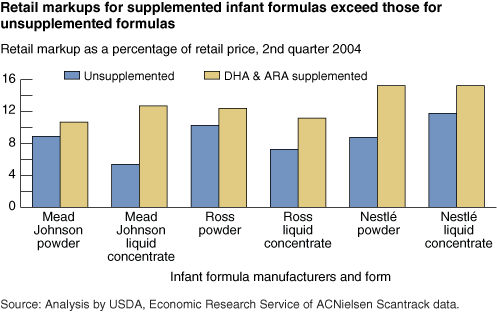Cost of Infant Formula for the WIC Program Rising
- by Victor Oliveira
- 11/1/2006
Over half of all infant formula sold in the U.S. is purchased through the Special Supplemental Nutrition Program for Women, Infants, and Children (WIC). An ERS study, the first to consider the impact of retail prices on WIC costs, finds that the cost of providing infant formula has increased in recent years. Since WIC is a discretionary program with fixed funding, this trend, if sustained, means that additional funds will be needed to maintain the level of services or that fewer low-income infants, young children, and women will be served.
Federal law requires that WIC State agencies enter into cost-containment contracts with infant formula manufacturers. Contracts are awarded to the manufacturer offering the lowest net wholesale price—the manufacturer’s wholesale price minus a rebate or discount provided by the manufacturer. In exchange for the rebate, the manufacturer receives an exclusive sales arrangement within the State: WIC participants in the State are given vouchers that can be redeemed in authorized retail foodstores only for that brand of formula.
The cost of infant formula to WIC has two components: (1) the net wholesale price—the payment ultimately received by the manufacturer; and (2) the retail markup—the retail price of the formula minus its wholesale price. Supermarket scanner data indicate that, for most States, the retail markup accounts for about 60 percent of the total cost to WIC. The size of the markup relative to the net wholesale price is largely due to the effectiveness of the rebate program. Rebates as a percentage of the wholesale price have ranged from 65 to 98 percent since 1998. In other words, infant formula purchased through WIC has cost States only 2 to 35 percent of its wholesale price, plus the retail markup.
This analysis suggests that both net wholesale price and retail markup have increased over time. However, much of the increase in costs is due to higher prices for infant formula supplemented with DHA and ARA (two fatty acids found in breast milk); these supplemented formulas average a much greater retail markup than unsupplemented formulas.
DHA- and ARA-supplemented formulas were first introduced in 2002, and by mid-2004 they accounted for almost two-thirds of total dollar sales of formula in supermarkets. Often, “new and improved” products carry price premiums that disappear over time. It is possible that the retail markups observed in this study for the supplemented formulas may lessen over time as well.
This article is drawn from:
- Oliveira, V. & Davis, D.E. (2006). Recent Trends and Economic Issues in the WIC Infant Formula Rebate Program. U.S. Department of Agriculture, Economic Research Service. ERR-22.


